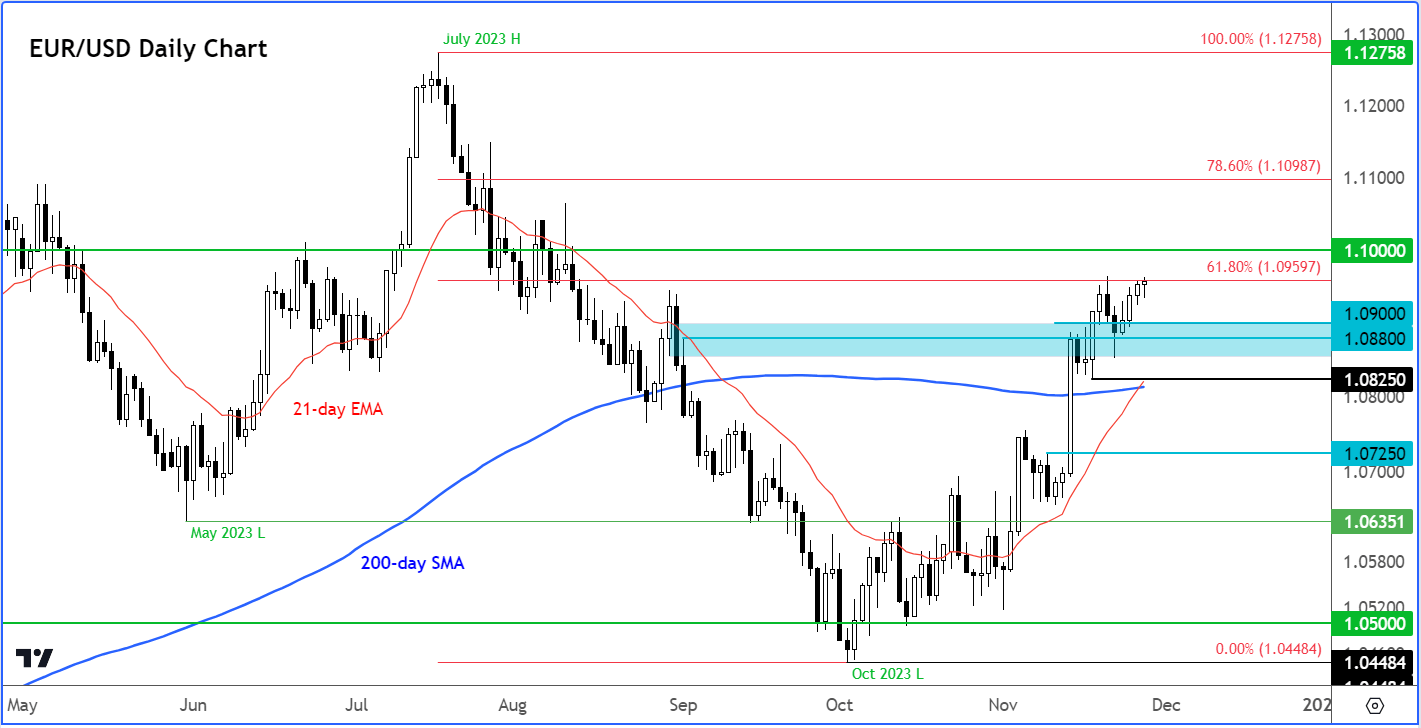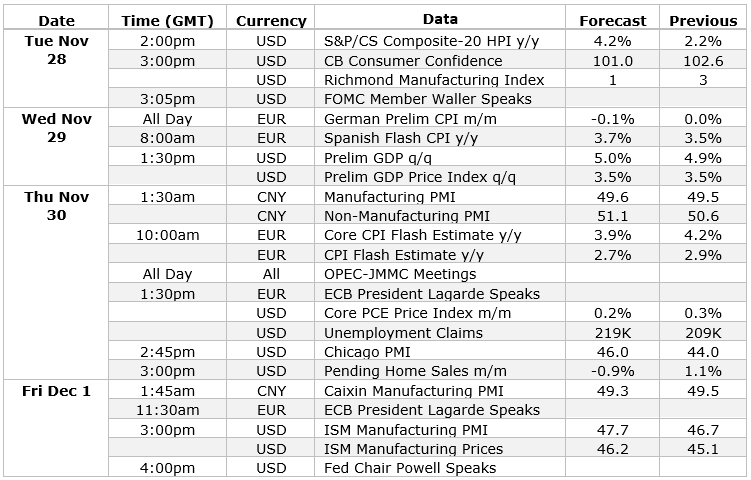
- EUR/USD analysis: Can weakening US dollar lift pair to above 1.10 handle?
- EUR/USD technical analysis suggests path of least resistance to the upside
- Eurozone CPI, US GDP and core PCE inflation among key data highlights this week
Welcome to another edition of Technical Tuesday, a weekly report where we highlight some of the most interesting markets that will hopefully appease technical analysts and traders alike. In this week’s report, we will analyse the EUR/USD pair.
Video analysis: EUR/USD, Gold, Silver and FTSE
It may have been a quietish start to the week, but that hasn’t stopped the dollar from weakening further. This has helped to keep foreign currencies supported. Among them, the EUR/USD has maintained its upward momentum. It was approaching the 1.10 handle, standing less than 50 pips away from this significant level. The month of November has been favourable for the EUR/USD, which has gained about 450 pips (4.25%) from its lowest to highest point. As we near the end of November, there was no signs of a reversal in the trend, meaning the EUR/USD was on course to potentially surpass the 500-pip mark, potentially break the 1.10 barrier and lay the groundwork for continued gains in December.
Before discussing the macro influences behind the EUR/USD’s recent movements, let’s take a look at the chart first and highlight some key technical levels first.
EUR/USD technical analysis

Source: TradingView.com
Holding above the 200-day average for 10 consecutive sessions signals strength, and therefore more reasons for the bears to stay out. Support around 1.0880 to 1.0900, a previous resistance zone, held firm last week. We need to see the EUR/USD bulls continuing defending this area to sustain the bullish momentum, and so far, they are doing just that.
The bears, meanwhile, will need to see a reversal signal before entering the fray. The critical level to watch is 1.0825, the most recent low. A breach could lead to a correction toward the prior breakout base near 1.0725, although this is not my primary expectation. Given the recent bullish momentum, it's more likely that the EUR/USD will advance towards, and potentially beyond, the 1.10 level rather than dipping below 1.0825 first.
EUR/USD analysis: Weakening US dollar underpins forex majors
The US dollar has been in a widespread decline as market sentiment increasingly leans towards the anticipation of an interest rate cut by the US central bank, possibly in the second quarter. The likelihood of a cut in May is approaching a 50% probability, according to the CME Group's FedWatch tool.
The dollar’s most recent decline was triggered by softer-than-expected CPI and PPI figures, which dampened the impact of recent hawkish comments from the Federal Reserve, thereby keeping yields under pressure. On Monday, new home sales data fell below expectations. The prospect of central banks adopting a more dovish stance globally has further excited global stock markets. As signs of global inflationary pressures gradually normalize worldwide, this trend is contributing to the sustained pressure on the dollar and fostering an increased appetite for foreign currencies.
Meanwhile, European data is finally exhibiting signs of stabilization. For instance, last week's PMI data surpassed expectations, although it still remains in contraction territory. Additionally, the German Ifo business climate index rose for the second consecutive month, indicating positive developments in the European economic landscape.
EUR/USD outlook: Eurozone CPI, US GDP and core PCE inflation among key data highlights
Traders are anticipating a crucial week for data, featuring inflation reports from both the eurozone and the US, along with GDP figures and several other key indicators in the US. Despite no expectations for further rate hikes, ECB President Christine Lagarde emphasized on Friday that the battle against inflation is ongoing.
The preliminary estimate for US GDP in the third quarter is scheduled for release on Wednesday. A significant deviation from the initial 4.9% annualized growth reported last month could impact the trajectory of the EUR/USD. The previous estimate exceeded expectations, leading to a positive response in the US dollar. The question now is whether a similar reaction will occur this time or if the markets are more focused on forward-looking data, considering that GDP figures are a couple of months old.
On Thursday, the core PCE price index is set to be released. After the US headline CPI fell below expectations, traders are eager to see if this weakening inflationary trend persists in the upcoming PCE figures. This is crucial for sustaining the belief that the Fed might lower interest rates in the first half of the coming year. The core PCE is typically the Fed's preferred inflation metric due to its lower volatility compared to traditional CPI measures. Therefore, a stronger reading could temper risk appetite, strengthen the US dollar, and prompt traders to reassess expectations of an earlier-than-expected rate cut in 2024. Conversely, a +0.2% reading or lower would likely align with the current market narrative of peaking interest rates and a potential rate cut in the first half of 2024, potentially weakening the US dollar and supporting the EUR/USD.
Insofar as today’s session is concerned, we have at least a few second-tier macro pointers to look forward to, with consumer confidence (CB), due at 15:00 GMT, probably being the most important one.
Here's this week’s full economic calendar, relevant to the EUR/USD pair:

How will EUR/USD react to Eurozone inflation data?
This Wednesday, we get fresh German inflation data, followed by the Eurozone flash CPI estimate the next day. In September, the latter dropped to a 4.2% annual rate from the previous month's 4.5%. Let's see if disinflation continues in October. If so, it could boost European stock markets, indirectly supporting the risk-sensitive euro.
So, if Eurozone inflation weakens, the EUR/USD might find support. It sounds paradoxical, but a weaker inflation scenario could actually stimulate interest in European stocks, offering indirect support for the euro. The chance of a move above 1.10 on the EUR/USD remains a strong possibility in my opinion, even with a weaker Eurozone inflation print.
-- Written by Fawad Razaqzada, Market Analyst
Follow Fawad on Twitter @Trader_F_R
How to trade with City Index
You can trade with City Index by following these four easy steps:
-
Open an account, or log in if you’re already a customer
• Open an account in the UK
• Open an account in Australia
• Open an account in Singapore
- Search for the company you want to trade in our award-winning platform
- Choose your position and size, and your stop and limit levels
- Place the trade










